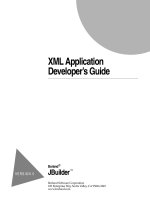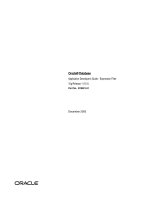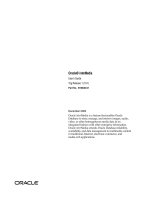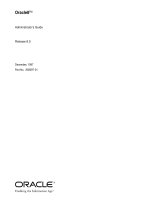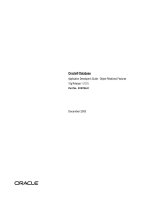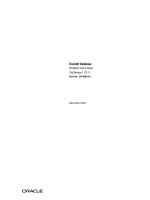Tài liệu Application Developer’s Guide - Expression Filter doc
Bạn đang xem bản rút gọn của tài liệu. Xem và tải ngay bản đầy đủ của tài liệu tại đây (1.7 MB, 134 trang )
Oracle® Database
Application Developer’s Guide - Expression Filter
10g Release 1 (10.1)
Part No. B10821-01
December 2003
Oracle Database Application Developer’s Guide - Expression Filter, 10g Release 1 (10.1)
Part No. B10821-01
Copyright © 2003 Oracle Corporation. All rights reserved.
Primary Author: Aravind Yalamanchi
Contributors: William Beauregard, Dieter Gawlick, Helen Grembowicz, Deborah Owens, and
Jagannathan Srinivasan
The Programs (which include both the software and documentation) contain proprietary information of
Oracle Corporation; they are provided under a license agreement containing restrictions on use and
disclosure and are also protected by copyright, patent and other intellectual and industrial property
laws. Reverse engineering, disassembly or decompilation of the Programs, except to the extent required
to obtain interoperability with other independently created software or as specified by law, is prohibited.
The information contained in this document is subject to change without notice. If you find any problems
in the documentation, please report them to us in writing. Oracle Corporation does not warrant that this
document is error-free. Except as may be expressly permitted in your license agreement for these
Programs, no part of these Programs may be reproduced or transmitted in any form or by any means,
electronic or mechanical, for any purpose, without the express written permission of Oracle Corporation.
If the Programs are delivered to the U.S. Government or anyone licensing or using the programs on
behalf of the U.S. Government, the following notice is applicable:
Restricted Rights Notice Programs delivered subject to the DOD FAR Supplement are "commercial
computer software" and use, duplication, and disclosure of the Programs, including documentation,
shall be subject to the licensing restrictions set forth in the applicable Oracle license agreement.
Otherwise, Programs delivered subject to the Federal Acquisition Regulations are "restricted computer
software" and use, duplication, and disclosure of the Programs shall be subject to the restrictions in FAR
52.227-19, Commercial Computer Software - Restricted Rights (June, 1987). Oracle Corporation, 500
Oracle Parkway, Redwood City, CA 94065.
The Programs are not intended for use in any nuclear, aviation, mass transit, medical, or other inherently
dangerous applications. It shall be the licensee's responsibility to take all appropriate fail-safe, backup,
redundancy, and other measures to ensure the safe use of such applications if the Programs are used for
such purposes, and Oracle Corporation disclaims liability for any damages caused by such use of the
Programs.
Oracle is a registered trademark, and Oracle Store, PL/SQL, and SQL*Plus are trademarks or registered
trademarks of Oracle Corporation. Other names may be trademarks of their respective owners.
iii
Contents
List of ExamplesList of Figures
Send Us Your Comments
.................................................................................................................. xi
Preface
........................................................................................................................................................... xiii
Audience ................................................................................................................................................ xiii
Documentation Accessibility .............................................................................................................. xiii
Related Documentation ...................................................................................................................... xiv
Conventions.......................................................................................................................................... xiv
1 Oracle Expression Filter Concepts
1.1 What Is Expression Filter?.................................................................................................... 1-1
1.1.1 Expression Filter Usage Scenarios ............................................................................... 1-2
1.2 Introduction to Expressions ................................................................................................. 1-3
1.2.1 Defining Attribute Sets .................................................................................................. 1-5
1.2.2 Defining Expression Columns ..................................................................................... 1-7
1.2.3 Inserting, Updating, and Deleting Expressions....................................................... 1-10
1.3 Applying the SQL EVALUATE Operator ....................................................................... 1-10
1.4 Evaluation Semantics.......................................................................................................... 1-13
1.5 Granting and Revoking Privileges.................................................................................... 1-13
1.6 Error Messages..................................................................................................................... 1-14
2 Indexing Expressions
2.1 Concepts of Indexing Expressions ...................................................................................... 2-1
iv
2.2 Indexable Predicates ............................................................................................................. 2-2
2.3 Index Representation ............................................................................................................ 2-2
2.4 Index Processing .................................................................................................................... 2-4
2.5 Predicate Table Query........................................................................................................... 2-6
2.6 Index Creation and Tuning .................................................................................................. 2-6
2.7 Index Usage .......................................................................................................................... 2-10
2.8 Index Storage and Maintenance ........................................................................................ 2-10
3 Expressions with XPath Predicates
3.1 Using XPath Predicates in Expressions .............................................................................. 3-1
3.2 Indexing XPath Predicates ................................................................................................... 3-3
3.2.1 Indexable XPath Predicates........................................................................................... 3-3
3.2.2 Index Representation ..................................................................................................... 3-4
3.2.3 Index Processing............................................................................................................. 3-5
3.2.4 Index Tuning for XPath Predicates.............................................................................. 3-6
4 Expression Filter Internal Objects
4.1 Attribute Set Object Type ..................................................................................................... 4-1
4.2 Expression Validation Trigger............................................................................................. 4-2
4.3 Expression Filter Index Objects ........................................................................................... 4-2
4.4 Expression Filter System Triggers....................................................................................... 4-2
5 Using Expression Filter with Utilities
5.1 Bulk Loading of Expression Data........................................................................................ 5-1
5.2 Exporting and Importing Tables, Users, and Databases ................................................. 5-3
5.2.1 Exporting and Importing Tables Containing Expression Columns ....................... 5-3
5.2.2 Exporting a User Owning Attribute Sets .................................................................... 5-4
5.2.3 Exporting a Database Containing Attribute Sets....................................................... 5-4
6 SQL Operators and Statements
EVALUATE ............................................................................................................................ 6-2
ALTER INDEX REBUILD..................................................................................................... 6-5
ALTER INDEX RENAME TO.............................................................................................. 6-7
v
CREATE INDEX .................................................................................................................... 6-8
DROP INDEX....................................................................................................................... 6-12
7 Object Types
EXF$ATTRIBUTE .................................................................................................................. 7-2
EXF$ATTRIBUTE_LIST........................................................................................................ 7-3
EXF$INDEXOPER ................................................................................................................. 7-4
EXF$TABLE_ALIAS.............................................................................................................. 7-6
EXF$XPATH_TAG ................................................................................................................ 7-7
EXF$XPATH_TAGS .............................................................................................................. 7-9
8 Management Procedures Using the DBMS_EXPFIL Package
ADD_ELEMENTARY_ATTRIBUTE Procedure ............................................................... 8-3
ADD_FUNCTIONS Procedure ........................................................................................... 8-5
ASSIGN_ATTRIBUTE_SET Procedure .............................................................................. 8-7
BUILD_EXCEPTIONS_TABLE Procedure ........................................................................ 8-9
CLEAR_EXPRSET_STATS Procedure.............................................................................. 8-10
COPY_ATTRIBUTE_SET Procedure ................................................................................ 8-11
CREATE_ATTRIBUTE_SET Procedure ........................................................................... 8-12
DEFAULT_INDEX_PARAMETERS Procedure.............................................................. 8-14
DEFAULT_XPINDEX_PARAMETERS Procedure......................................................... 8-16
DEFRAG_INDEX Procedure ............................................................................................. 8-19
DROP_ATTRIBUTE_SET Procedure................................................................................ 8-20
GET_EXPRSET_STATS Procedure ................................................................................... 8-21
GRANT_PRIVILEGE Procedure ....................................................................................... 8-22
INDEX_PARAMETERS Procedure................................................................................... 8-24
REVOKE_PRIVILEGE Procedure ..................................................................................... 8-27
UNASSIGN_ATTRIBUTE_SET Procedure...................................................................... 8-29
VALIDATE_EXPRESSIONS Procedure ........................................................................... 8-30
XPINDEX_PARAMETERS Procedure ............................................................................. 8-32
vi
9 Expression Filter Views
9.1 USER_EXPFIL_ASET_FUNCTIONS View ........................................................................ 9-2
9.2 USER_EXPFIL_ATTRIBUTES View ................................................................................... 9-2
9.3 USER_EXPFIL_ATTRIBUTE_SETS View .......................................................................... 9-3
9.4 USER_EXPFIL_DEF_INDEX_PARAMS View .................................................................. 9-3
9.5 USER_EXPFIL_EXPRESSION_SETS View ........................................................................ 9-3
9.6 USER_EXPFIL_EXPRSET_STATS View ............................................................................ 9-4
9.7 USER_EXPFIL_INDEX_PARAMS View ............................................................................ 9-5
9.8 USER_EXPFIL_INDEXES View .......................................................................................... 9-6
9.9 USER_EXPFIL_PREDTAB_ATTRIBUTES View............................................................... 9-6
9.10 USER_EXPFIL_PRIVILEGES View..................................................................................... 9-7
A Managing Expressions Defined on One or More Database Tables
B Application Examples
C Installing Oracle Expression Filter
Index
vii
List of Examples
1–1 Defining an Attribute Set From an Existing Object Type ................................................ 1-5
1–2 Defining an Attribute Set Incrementally............................................................................ 1-6
1–3 Adding User-Defined Functions to an Attribute Set ....................................................... 1-7
1–4 Inserting an Expression into the Consumer Table ......................................................... 1-10
1–5 Inserting an Expression That References a User-Defined Function ............................ 1-10
viii
List of Figures
1–1 Expression Datatype ............................................................................................................. 1-9
2–1 Conceptual Predicate Table ................................................................................................. 2-3
3–1 Conceptual Predicate Table with XPath Predicates ......................................................... 3-5
ix
List of Tables
6–1 Expression Filter Index Creation and Usage Statements................................................. 6-1
8–1 DBMS_EXPFIL Procedures .................................................................................................. 8-1
9–1 Expression Filter Views ........................................................................................................ 9-1
x
xi
Send Us Your Comments
Oracle Database Application Developer’s Guide - Expression Filter, 10g Release 1 (10.1)
Part No. B10821-01
Oracle Corporation welcomes your comments and suggestions on the quality and usefulness of this
publication. Your input is an important part of the information used for revision.
■
Did you find any errors?
■
Is the information clearly presented?
■
Do you need more information? If so, where?
■
Are the examples correct? Do you need more examples?
■
What features did you like most about this manual?
If you find any errors or have any other suggestions for improvement, please indicate the title and
part number of the documentation and the chapter, section, and page number (if available). You can
send comments to us in the following ways:
■
Electronic mail:
■
FAX: 603.897.3825 Attn: Expression Filter Documentation
■
Postal service:
Oracle Corporation
Expression Filter Documentation
One Oracle Drive
Nashua, NH 03062-2804
USA
If you would like a reply, please provide your name and contact information.
If you have problems with the software, please contact your local Oracle Support Services.
xii
xiii
Preface
Oracle Database Application Developer’s Guide - Expression Filter provides usage and
reference information about Expression Filter, a feature of Oracle Database that
stores, indexes, and evaluates conditional expressions in relational tables.
Audience
Application developers and DBAs can save time and labor by using Oracle
Expression Filter to store and evaluate large sets of conditional expressions in the
database. Conditional expressions can describe business rules and interests in
expected data for applications involving personalized information distribution,
demand analysis, and task assignment.
Documentation Accessibility
Our goal is to make Oracle products, services, and supporting documentation
accessible, with good usability, to the disabled community. To that end, our
documentation includes features that make information available to users of
assistive technology. This documentation is available in HTML format, and contains
markup to facilitate access by the disabled community. Standards will continue to
evolve over time, and Oracle Corporation is actively engaged with other
market-leading technology vendors to address technical obstacles so that our
documentation can be accessible to all of our customers. For additional information,
visit the Oracle Accessibility Program Web site at
/>Accessibility of Code Examples in Documentation
JAWS, a Windows screen
reader, may not always correctly read the code examples in this document. The
xiv
conventions for writing code require that closing braces should appear on an
otherwise empty line; however, JAWS may not always read a line of text that
consists solely of a bracket or brace.
Accessibility of Links to External Web Sites in Documentation
This
documentation may contain links to Web sites of other companies or organizations
that Oracle Corporation does not own or control. Oracle Corporation neither
evaluates nor makes any representations regarding the accessibility of these Web
sites.
Related Documentation
Refer to the following documentation for information about related products:
■
Oracle Database SQL Reference
■
Oracle Database Utilities
■
Oracle Database Error Messages
■
Oracle Database Performance Tuning Guide
■
Oracle XML DB Developer's Guide
■
Oracle Database Application Developer's Guide - Object-Relational Features
Printed documentation is available for sale in the Oracle Store at
/>To download free release notes, installation documentation, white papers, or other
collateral, please visit the Oracle Technology Network (OTN). You must register
online before using OTN; registration is free and can be done at
/>If you already have a username and password for OTN, then you can go directly to
the documentation section of the OTN Web site at
/>Conventions
This section describes the conventions used in the text and code examples of this
document. The following table describes those conventions and provides examples
of their use.
xv
Convention Meaning Example
[ ] Brackets enclose one or more optional
items. Do not enter the brackets.
DECIMAL (digits [ , precision ])
{ } Braces enclose two or more items, one of
which is required. Do not enter the braces.
{ENABLE | DISABLE}
| A vertical bar represents a choice of two
or more options within brackets or braces.
Enter one of the options. Do not enter the
vertical bar.
{ENABLE | DISABLE}
[COMPRESS | NOCOMPRESS]
... Horizontal ellipsis points indicate either:
■
That we have omitted parts of the
code that are not directly related to
the example
■
That you can repeat a portion of the
code
CREATE TABLE ... AS subquery;
SELECT col1, col2, ... , coln FROM
employees;
.
.
.
Vertical ellipsis points indicate that we
have omitted several lines of code not
directly related to the example.
Bold Bold typeface indicates terms that are
defined in the text or terms that appear in
a glossary, or both.
When you specify this clause, you create an
index-organized table.
UPPERCASE
monospace
(fixed-width
font)
Uppercase monospace typeface indicates
elements supplied by the system.
You can back up the database by using the
BACKUP command.
Query the TABLE_NAME column in the USER_
TABLES data dictionary view.
Use the DBMS_STATS.GENERATE_STATS
procedure.
lowercase
monospace
(fixed-width
font)
Lowercase monospace typeface indicates
executables, filenames, directory names,
and sample user-supplied elements.
Enter sqlplus to open SQL*Plus.
Back up the datafiles and control files in the
/disk1/oracle/dbs directory.
The department_id, department_name,
and location_id columns are in the
hr.departments table.
lowercase
monospace
(fixed-width
font) italic
Lowercase monospace italic font
represents placeholders or variables.
You can specify the parallel_clause.
Run Uold_release.SQL where old_
release refers to the release you installed
prior to upgrading.
xvi
Oracle Expression Filter Concepts 1-1
1
Oracle Expression Filter Concepts
Oracle Expression Filter is a feature of Oracle Database that allows application
developers to store, index, and evaluate conditional expressions (expressions) in
one or more columns of a relational table. Expressions are a useful way to describe
interests in expected data.
Expression Filter matches incoming data with expressions stored in a column to
identify rows of interest. It can also derive complex relationships by matching data
in one table with expressions in a second table. Expression Filter simplifies SQL
queries; allows expressions to be inserted, updated, and deleted without changing
the application; and enables reuse of conditional expressions in business rules by
separating them from the application and storing them in the database.
Applications involving information distribution, demand analysis, and task
assignment can benefit from Expression Filter.
1.1 What Is Expression Filter?
Expression Filter provides a datatype, operator, and indextype to store, evaluate,
and index expressions that describe an interest in a data item or piece of
information. Expressions are stored in a column of a user table. Expression Filter
matches expressions in a column with a data item passed by a SQL statement or
with data stored in one or more tables, and evaluates each expression to be true or
false. Optionally, expressions can be indexed when using the Enterprise Edition of
Oracle Database. Expression Filter includes the following elements:
■
Expression datatype: A virtual datatype created through a constraint placed on
a VARCHAR2 column in a user table that stores expressions.
■
EVALUATE operator: An operator that evaluates expressions for each data item.
■
Administrative utilities: A set of utilities that validate expressions and suggest
optimal index structure.
What Is Expression Filter?
1-2 Oracle Database Application Developer’s Guide - Expression Filter
■
Expression indexing: Enhances performance of the EVALUATE operator for
large expression sets. Expression indexing is available in Oracle Database
Enterprise Edition.
1.1.1 Expression Filter Usage Scenarios
The following sections are examples of how you can use Expression Filter.
Match Incoming Data with Conditional Expressions
Expression Filter can match incoming data with conditional expressions stored in
the database to identify rows of interest. For example, consider an application that
matches buyers and sellers of cars. A table called Consumer includes a column
called BUYER_PREFERENCES with an Expression datatype. The BUYER_
PREFERENCES column stores an expression for each consumer that describes the
kind of car the consumer wants to purchase, including make, model, year, mileage,
color, options, and price. Data about cars for sale is included with the EVALUATE
operator in the SQL WHERE clause. The SQL EVALUATE operator matches the
incoming car data with the expressions to find prospective buyers.
The SQL EVALUATE operator also enables batch processing of incoming data. Data
can be stored in a table called CARS and matched with expressions stored in the
CONSUMER table using a join between the two tables.
The SQL EVALUATE operator saves time by matching a set of expressions with
incoming data and enabling large expression sets to be indexed for performance.
This saves labor by allowing expressions to be inserted, updated, and deleted
without changing the application and providing a results set that can be
manipulated in the same SQL statement, for instance to order or group results. In
contrast, a procedural approach stores results in a temporary table that must be
queried for further processing, and those expressions cannot be indexed.
Maintain Complex Table Relationships
Expression Filter can convey N-to-M (many-to-many) relationships between tables.
Using the previous example:
■
A car may be of interest to one or more buyers.
■
A buyer may be interested in one or more cars.
■
A seller may be interested in one or more buyers.
To answer questions about these relationships, the incoming data about cars is
stored in a table called CARS with an Expression column (column of Expression
datatype) called SELLER_PREFERENCES. The CONSUMERS table includes a column
Introduction to Expressions
Oracle Expression Filter Concepts 1-3
called BUYER_PREFERENCES. The SQL EVALUATE operator can answer questions
such as:
■
What cars are of interest to each consumer?
■
What buyers are of interest to each seller?
■
What demand exists for each car? This can help to determine optimal pricing.
■
What unsatisfied demand is there? This can help to determine inventory
requirements.
This declarative approach saves labor. No action is needed if changes are made to
the data or the expressions. Compare this to the traditional approach where a
mapping table is created to store the relationship between the two tables. A trigger
must be defined to recompute the relationships and to update the mapping table if
the data or expressions change. In this case, new data must be compared to all
expressions, and a new expression must be compared to all data.
Application Attributes
Expression Filter is a good fit for applications where the data has the following
attributes:
■
A large number of data items exists to be evaluated.
■
Each data item has structured data attributes, for example VARCHAR,
NUMBER, DATE, XMLTYPE.
■
Incoming data is evaluated by a significant number of unique and persistent
queries containing expressions.
■
The expression (in SQL WHERE clause format) describes an interest in incoming
data items.
■
The expressions compare attributes to values using relational operators (=, !=, <,
>, and so on).
1.2 Introduction to Expressions
Expressions describe interests in an item of data. Expressions are stored in a column
of a user table and compared, using the SQL EVALUATE operator, to incoming data
items specified in a SQL WHERE clause or to a table of data. Expressions are
evaluated as true or false or return a null value if an expression does not exist for a
row.
Introduction to Expressions
1-4 Oracle Database Application Developer’s Guide - Expression Filter
An expression describes interest in an item of data using one or more variables,
known as elementary attributes. An expression can also include literals, Oracle
supplied functions, user-defined functions, and table aliases. A valid expression
consists of one or more simple conditions called predicates. The predicates in the
expression are linked by the logical operators AND and OR. Expressions must adhere
to the SQL WHERE clause format. (For more information about the SQL WHERE
clause, see Oracle Database SQL Reference.) An expression is not required to use all
the defined elementary attributes; however, the incoming data must provide a value
for every elementary attribute. Null is an acceptable value.
For example, the following expression includes the UPPER Oracle supplied function
and captures the interest of a user in a car (the data item) with the model, price, and
year as elementary attributes.
UPPER(Model) = 'TAURUS' and Price < 20000 and Year > 2000
Expressions are stored in a column of a user table with an Expression datatype. The
values stored in a column of this type are constrained to be expressions. (See
Section 1.2.2.) A user table can have one or more Expression columns. A query to
display the contents of an Expression column displays the expressions in string
format.
You insert, update, and delete expressions using standard SQL. A group of
expressions that are stored in a single column is called an expression set and shares
a common set of elementary attributes. This set of elementary attributes plus any
functions used in the expressions are the metadata for the expression set. This
metadata is referred to as the attribute set. The attribute set consists of the
elementary attribute names and their datatypes and any functions used in the
expressions. The attribute set is used by the Expression column to validate changes
and additions to the expression set. An expression stored in the Expression column
can use only the elementary attribute and functions defined in the corresponding
attribute set. Expressions cannot contain subqueries.
Expression Filter provides the DBMS_EXPFIL package which contains procedures
to manage the expression data.
There are four basic steps to create and use an Expression column:
1.
Define an attribute set. See Section 1.2.1.
2.
Define an Expression column in a user table. See Section 1.2.2.
3.
Insert expressions in the table. See Section 1.2.3.
4.
Apply the SQL EVALUATE operator to compare expressions to incoming data
items. See Section 1.3.
Introduction to Expressions
Oracle Expression Filter Concepts 1-5
The remaining sections in this chapter guide you through this procedure.
1.2.1 Defining Attribute Sets
A special form of an Oracle object type is used to create an attribute set. (For more
information about object types, see Oracle Database Application Developer's Guide -
Object-Relational Features.)
The attribute set defines the elementary attributes for an expression set. It implicitly
allows all Oracle supplied SQL functions to be valid references in the expression set.
If the expression set refers to a user-defined function, it must be explicitly added to
the attribute set. An elementary attribute in an attribute set can refer to data stored
in another database table using table alias constructs. One or more or all elementary
attributes in an attribute set can be table aliases. If an elementary attribute is a table
alias, the value assigned to the elementary attribute is a ROWID from the
corresponding table. For more information about table aliases, see Appendix A.
You can create an attribute set using one of two approaches:
■
Use an existing object type to create an attribute set with the same name as the
object type. This approach is most appropriate to use when the attribute set
does not contain any table alias elementary attributes. You use the CREATE_
ATTRIBUTE_SET procedure of the DBMS_EXPFIL package. See Example 1–1.
■
Individually add elementary attributes to an existing attribute set. Expression
Filter automatically creates an object type to encapsulate the elementary
attributes and gives it the same name as the attribute set. This approach is most
appropriate to use when the attribute set contains one or more elementary
attributes defined as table aliases. You use the ADD_ELEMENTARY_
ATTRIBUTE procedure of the DBMS_EXPFIL package. See Example 1–2.
If the expressions refer to user-defined functions, you must add the functions to the
corresponding attribute set, using the ADD_FINCTIONS procedure of the DBMS_
EXPFIL package. See Example 1–3.
Attribute Set Examples
Example 1–1 shows how to use an existing object type to create an attribute set. It
uses the CREATE_ATTRIBUTE_SET procedure.
Example 1–1 Defining an Attribute Set From an Existing Object Type
CREATE OR REPLACE TYPE Car4Sale AS OBJECT
(Model VARCHAR2(20),
Year NUMBER,
Introduction to Expressions
1-6 Oracle Database Application Developer’s Guide - Expression Filter
Price NUMBER,
Mileage NUMBER);
/
BEGIN
DBMS_EXPFIL.CREATE_ATTRIBUTE_SET(attr_set => 'Car4Sale',
from_type => 'YES');
END;
/
For more information about the CREATE_ATTRIBUTE_SET procedure, see
"CREATE_ATTRIBUTE_SET Procedure" in Chapter 8.
Example 1–2 shows how to create an attribute set Car4Sale and how to define the
variables one at a time. It uses the CREATE_ATTRIBUTE_SET and ADD_
ELEMENTARY_ATTRIBUTE procedures.
Example 1–2 Defining an Attribute Set Incrementally
BEGIN
DBMS_EXPFIL.CREATE_ATTRIBUTE_SET(attr_set => 'Car4Sale');
DBMS_EXPFIL.ADD_ELEMENTARY_ATTRIBUTE(
attr_set => 'Car4Sale',
attr_name => 'Model',
attr_type => 'VARCHAR2(20)');
DBMS_EXPFIL.ADD_ELEMENTARY_ATTRIBUTE(
attr_set => 'Car4Sale',
attr_name => 'Year',
attr_type => 'NUMBER');
DBMS_EXPFIL.ADD_ELEMENTARY_ATTRIBUTE(
attr_set => 'Car4Sale',
attr_name => 'Price',
attr_type => 'NUMBER');
DBMS_EXPFIL.ADD_ELEMENTARY_ATTRIBUTE(
attr_set => 'Car4Sale',
attr_name => 'Mileage',
attr_type => 'NUMBER');
END;
/
For more information about the ADD_ELEMENTARY_ATTRIBUTE procedure, see
"ADD_ELEMENTARY_ATTRIBUTE Procedure" in Chapter 8.
Introduction to Expressions
Oracle Expression Filter Concepts 1-7
If the expressions refer to user-defined functions, you must add the functions to the
corresponding attribute set. Example 1–3 shows how to add user-defined functions,
using the ADD_FUNCTIONS procedure, to an attribute set.
Example 1–3 Adding User-Defined Functions to an Attribute Set
CREATE or REPLACE FUNCTION HorsePower(Model VARCHAR2, Year VARCHAR2)
return NUMBER is
BEGIN
-- Derive HorsePower from other relational tables uisng Model and Year values.--
return 200;
END HorsePower;
/
CREATE or REPLACE FUNCTION CrashTestRating(Model VARCHAR2, Year VARCHAR2)
return NUMBER is
BEGIN
-- Derive CrashTestRating from other relational tables using Model --
-- and Year values. --
return 5;
END CrashTestRating;
/
BEGIN
DBMS_EXPFIL.ADD_FUNCTIONS (attr_set => 'Car4Sale',
funcs_name => 'HorsePower');
DBMS_EXPFIL.ADD_FUNCTIONS (attr_set => 'Car4Sale',
funcs_name => 'CrashTestRating');
END;
/
For more information about the ADD_FUNCTIONS procedure, see "ADD_
FUNCTIONS Procedure" in Chapter 8.
To drop an attribute set, you use the DROP_ATTRIBUTE_SET procedure. For more
information, see "DROP_ATTRIBUTE_SET Procedure" in Chapter 8.
1.2.2 Defining Expression Columns
Expression is a virtual datatype. Assigning an attribute set to a VARCHAR2 column
in a user table creates an Expression column. The attribute set determines which
elementary attributes and user-defined functions can be used in the expression set.
An attribute set can be used to create multiple columns of Expression datatype in
Introduction to Expressions
1-8 Oracle Database Application Developer’s Guide - Expression Filter
the same table and in other tables in the same schema. Note that an attribute set in
one schema cannot be associated with a column in another schema.
To create an Expression column:
1.
Add a VARCHAR2 column to a table or create a table with the VARCHAR2
column. An existing VARCHAR2 column in a user table can also be used for this
purpose. The following example creates a table with a VARCHAR2 column,
Interest, that will be used with an attribute set:
CREATE TABLE Consumer (CId NUMBER,
Zipcode NUMBER,
Phone VARCHAR2(12),
Interest VARCHAR2(200));
2.
Assign an attribute set to the column, using the ASSIGN_ATTRIBUTE_SET
procedure. The following example assigns an attribute set to a column named
Interest in a table called Consumer:
BEGIN
DBMS_EXPFIL.ASSIGN_ATTRIBUTE_SET (
attr_set => 'Car4Sale',
expr_tab => 'Consumer',
expr_col => 'Interest');
END;
/
For more information about the ASSIGN_ATTRIBUTE_SET procedure, see
"ASSIGN_ATTRIBUTE_SET Procedure" in Chapter 8.
Figure 1–1 is a conceptual image of consumers' interests (in trading cars) being
captured in a Consumer table.
Introduction to Expressions
Oracle Expression Filter Concepts 1-9
Figure 1–1 Expression Datatype
To remove an attribute set from a column, you use the UNASSIGN_ATTRIBUTE_
SET procedure of the DBMS_EXPFIL package. See "UNASSIGN_ATTRIBUTE_SET
Procedure" in Chapter 8.
To drop an attribute set not being used for any expression set, you use the DROP_
ATTRIBUTE_SET procedure of the DBMS_EXPFIL package. See "DROP_
ATTRIBUTE_SET Procedure" in Chapter 8.
To copy an attribute set across schemas, you use the COPY_ATTRIBUTE_SET
procedure of the DBMS_EXPFIL package. See "COPY_ATTRIBUTE_SET Procedure"
in Chapter 8.
Elementary Attributes
Model VARCHAR2(30)
Price NUMBER
Mileage NUMBER
Year NUMBER
Oracle Supplied Functions
UPPER
LOWER
. . .
User-Defined Functions
CrashTestRating
HorsePower
Attribute Set: Car4Sale
CId Zipcode
Phone
Interest
1
2
3
..
32611
03060
03060
..
917 768 4633
603 983 3463
603 484 7013
..
Model = 'Taurus' and Price < 15000
and Mileage < 25000
Model = 'Mustang' and Year > 1999
and Price < 20000
HorsePower(Model, Year) > 200
and Price < 20000
..
Consumer Table
